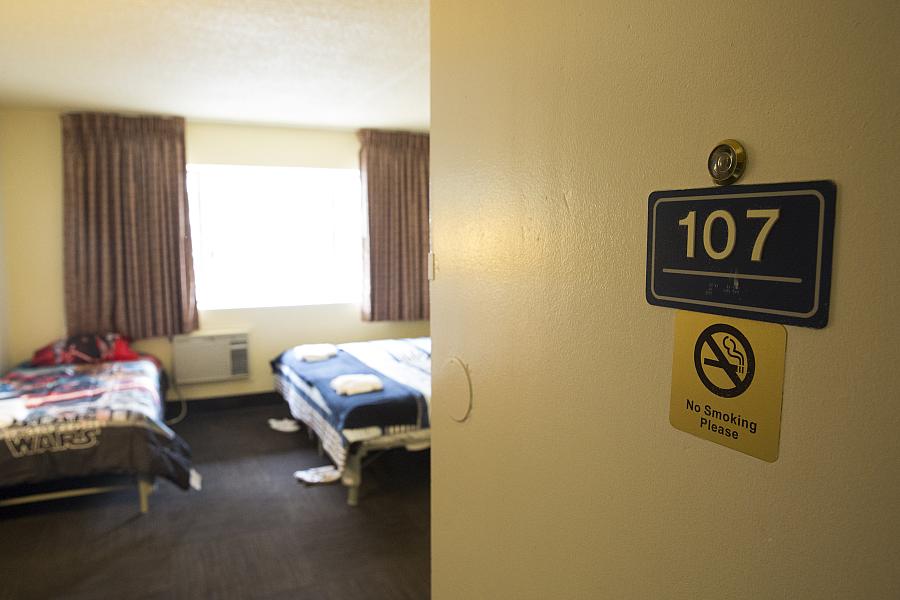While some states push for work requirements, Washington state is using Medicaid to get people housed

(Photo: Jason Redmond/AFP/Getty Images)
As Kentucky becomes the first state to adopt Medicaid work requirements, others states such as Washington are pursuing a completely different approach to transforming the government health care program.
This month, Washington state moved forward with a pilot program to offer supportive housing services to Medicaid enrollees. As part of its larger federal waiver project that launched last year, the state has earmarked nearly $200 million for supportive housing and supported employment services.
While federal Medicaid rules draw a hard line against using health care dollars for housing itself, the money can be used on services that connect people with permanent supportive housing and help them stay there. That’s key to the overall process, said Kate Baber, a homelessness policy and advocacy specialist at the Washington Low Income Housing Alliance, a Seattle-based nonprofit. While other sources can fund the construction or purchase of homes, housing efforts need these ongoing support services to be effective, she said. Such services can help people not only find housing but learn how to stay in that housing by being a good tenant.
Along with saving health care dollars, housing can lead to improved health, advocates say.
“The intent is: If you help them stabilize their housing and employment, they can feel safer and more stable in those needs,” said Jon Brumbach, a senior health policy analyst at the Washington State Health Care Authority. Then, “they can access better services for their complex health needs.”
Washington state is part of a broader effort across the country that seeks to integrate housing and health, led by states such as California, New York, Oregon, Louisiana, Maryland and Massachusetts.
What distinguishes Washington is how comprehensive its supportive housing services are, covering the needs of people with complex physical and behavioral health conditions, said Peggy Bailey, the director of health integration for the Center on Budget and Policy Priorities. She pointed to services ranging from help finding an apartment to eviction prevention support.
“Washington provides a pathway for other states to show the level of services needed for these high-need populations,” she said.
A broader view of what shapes health
After expanding Medicaid under the Affordable Care Act, Washington health officials noticed a different set of needs among many of its new enrollees. People who were primarily focused on survival had let their health needs fall by the wayside. Addressing the needs of these high-risk individuals wasn’t as simple as giving them access to a primary care physician; they needed to stabilize their living situations.
Brumbach offered the example of an emergency department “frequent flier” — a homeless individual who shows up several times a week. Now, the hospital can use Medicaid dollars to connect him to a supportive housing provider. That provider will assess his needs and connect him to services. Ideally, the patient is placed in housing with ongoing support that helps him with everything from maintaining the unit in good condition to ensuring he stays compliant with the lease.
"The fact that Medicaid doesn’t pay for the one thing that really helps people is really unfortunate. We’ll pay for all sorts of unnecessary and useless health care treatments rather than the one treatment that really makes a difference." — Dr. Joshua Bamberger, UCSF School of Medicine
Once people have stable housing, they’re more likely to access primary and preventative care instead of seeking far more expensive and inconsistent treatment in the emergency department, he said.
Brumbach says he’s well aware this isn’t an overnight fix. For one, there needs to be enough housing units, which can be tough to find in tight rental markets like Seattle. There are logistical hurdles, too, such as ensuring community-based organization and nonprofits are capable of billing Medicaid.
But Brumbach says these efforts have to start somewhere.
“So much of housing is driven by crisis response,” he said. “We’re trying to demonstrate a long-term solution.”
There’s no place like home
While efforts like Washington’s are a step in the right direction, Medicaid should really be paying directly for housing itself, said Dr. Joshua Bamberger, an associate clinical professor at the UCSF School of Medicine who advocates for homeless people and has written about embracing housing as a Medicaid benefit.
“The fact that Medicaid doesn’t pay for the one thing that really helps people is really unfortunate,” he said in an interview with the Center for Health Journalism. “We’ll pay for all sorts of unnecessary and useless health care treatments rather than the one treatment that really makes a difference.”
He also places the responsibility for funding more housing on nonprofit hospitals, many of which have seen revenues soar since the Affordable Care Act’s Medicaid expansion. In exchange for their tax-exempt status, these hospitals have a “community benefit” requirement. Using that money to fund housing for homeless people would have a big impact, he said.
That’s already happening in some communities. Just last week, Chicago Tribune reporter Alexia Elejalde-Ruiz wrote about a hospital partnering with a nonprofit to house the homeless: “The idea is that providing the homeless with stable housing in the long run costs less than leaving them to fend for themselves on the streets, where they are more vulnerable to illness, violence and desperation that ultimately drive up health care costs.”
Bamberger called on health journalists to look into the issue in their own communities.
“The story that is really ripe for being written is about the responsibility hospitals have to give back to the community,” he said.
While he views the Trump Administration’s approval of Medicaid work requirements as a way to simply cull Medicaid rolls, he does see some common ground among seemingly disparate approaches. Ultimately, having Medicaid pay for housing would reduce government expenses, he said.
“There’s an overlap between doing the right thing and reducing government size with an investment in housing for homeless people.”
**

